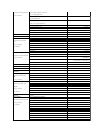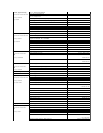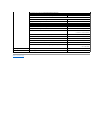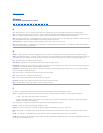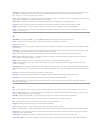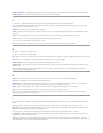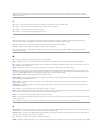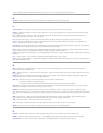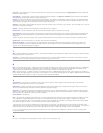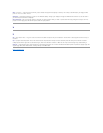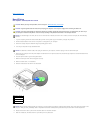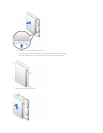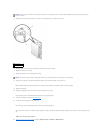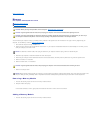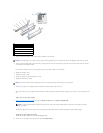
Service tag — A bar code label on your computer that identifies your computer when you access Dell | Support at support.dell.com or when you call Dell for
customer or technical support.
Setup program — A program that is used to install and configure hardware and software. The setup.exe or install.exe program comes with most Windows
software packages. Setup program differs from system setup program.
Shortcut — An icon that provides quick access to frequently used programs, files, folders, and drives. When you place a shortcut on your Windows desktop
and double-click the icon, you can open its corresponding folder or file without having to find it first. Shortcut icons do not change the location of files. If you
delete a shortcut, the original file is not affected. Also, you can rename a shortcut icon.
Shutdown — The process of closing windows and programs, exiting the operating system, and turning off your computer. You can lose data if you turn off your
computer before completing a shutdown.
Software — Anything that can be stored electronically, such as computer files or programs.
Standby mode — A power management mode that shuts down all unnecessary computer operations to save energy.
Surge protectors — Prevents voltage spikes, such as those that may occur during an electrical storm, from entering the system through the electrical outlet.
They do not protect against lightning strikes or against brownouts, which occur when the voltage drops more than 20 percent below the normal AC line
voltage level.
Network connections cannot be protected by surge protectors. Always disconnect the network cable from the network connector during electrical storms.
System board — The main circuit board in your computer. Also known as the motherboard.
System setup program — A utility that serves as an interface between the computer hardware and the operating system. System setup allows you to
configure user-selectable options in the BIOS such as date and time or system password. Unless you understand what effect the settings have on the
computer, do not change the settings for this program.
T
TAPI — telephony application programming interface — Enables Microsoft Windows program applications to operate with a wide variety of telephony devices,
including voice, data, fax, video, and so on.
Text editor — A program used to create and edit files that contain only text; for example, Windows Notepad uses a text editor. Text editors do not usually
provide word wrap or formatting functionality (the option to underline, change fonts, and so on).
U
UPS — uninterruptible power supply — A backup power source used when the electrical power fails or drops to an unacceptable voltage level. A UPS keeps a
computer running for a limited amount of time when there is no electrical power. UPS systems typically provide surge suppression and may also provide
voltage regulation. Small UPS systems provide battery power for a few minutes to enable you to shut down your computer.
USB — universal serial bus — A hardware interface for a low-speed device such as a USB-compatible keyboard, mouse, joystick, scanner, set of speakers, or
printer. Devices are plugged directly into a 4-pin socket on your computer or into a multi-port hub that plugs into your computer. USB devices can be connected
and disconnected while the computer is turned on, and they can also be daisy-chained together.
V
Video controller — The circuitry on a video card or on the system board (in computers with an integrated video controller) that provides the video
capabilities—in combination with the monitor—for your computer.
Video memory — Memory that consists of memory chips dedicated to video functions. Video memory is usually faster than system memory. The amount of
video memory installed primarily influences the number of colors that a program can display.
Video mode — A mode that describes how text and graphics are displayed on a monitor. Graphics-based software, such as the Windows operating system,
displays in video modes that can be defined as x horizontal pixels by y vertical pixels by z colors. Character-based software, such as text editors, displays in
video modes that can be defined as x columns by y rows of characters.
Video resolution — See resolution.
Virus — A program that is designed to inconvenience you or to destroy data stored on your computer. A virus program moves from one computer to another
via an infected disk, software downloaded from the Internet, or e-mail attachments. When an infected program starts, its embedded virus also starts.
A virus cannot be attached to data. It must be attached to a program that is downloaded into or installed on the computer. Macro viruses, although hidden
within documents (data), are similar. It is in the execution of the macro that the damage is done.
A common type of virus is a boot virus, which is stored in the boot sectors of a floppy disk. If the floppy disk is left in the drive when the computer is shut
down and then turned on, the computer is infected when it reads the boot sectors of the floppy disk expecting to find the operating system. If the computer is
infected, the boot virus may replicate itself onto all of the floppy disks that are read or written in that computer until the virus is eradicated.
V — volt — The measurement of electric potential or electromotive force. One V appears across a resistance of 1 ohm when a current of 1 ampere flows
through that resistance.
W
W — watt — The measurement of electrical power. One W is 1 ampere of current flowing at 1 volt.



